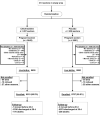Impact of newborn skin-cleansing with chlorhexidine on neonatal mortality in southern Nepal: a community-based, cluster-randomized trial
- PMID: 17210728
- PMCID: PMC2364722
- DOI: 10.1542/peds.2006-1192
Impact of newborn skin-cleansing with chlorhexidine on neonatal mortality in southern Nepal: a community-based, cluster-randomized trial
Abstract
Objective: Hospital-based data from Africa suggest that newborn skin-cleansing with chlorhexidine may reduce neonatal mortality. Evaluation of this intervention in the communities where most births occur in the home has not been done. Our objective was to assess the efficacy of a 1-time skin-cleansing of newborn infants with 0.25% chlorhexidine on neonatal mortality.
Methods: The design was a community-based, placebo-controlled, cluster-randomized trial in Sarlahi District in southern Nepal. Newborn infants were cleansed with infant wipes that contained 0.25% chlorhexidine or placebo solution as soon as possible after delivery in the home (median: 5.8 hours). The primary outcome was all-cause mortality by 28 days. After the completion of the randomized phase, all newborns in study clusters were converted to chlorhexidine treatment for the subsequent 9 months.
Results: A total of 17,530 live births occurred in the enrolled sectors, 8650 and 8880 in the chlorhexidine and placebo groups, respectively. Baseline characteristics were similar in the treatment groups. Intention-to-treat analysis among all live births showed no impact of the intervention on neonatal mortality. Among live-born infants who actually received their assigned treatment (98.7%), there was a nonsignificant 11% lower neonatal mortality rate among those who were treated with chlorhexidine compared with placebo. Low birth weight infants had a statistically significant 28% reduction in neonatal mortality; there was no significant difference among infants who were born weighing > or = 2500 g. After conversion to active treatment in the placebo clusters, there was a 37% reduction in mortality among low birth weight infants in the placebo clusters versus no change in the chlorhexidine clusters.
Conclusions: Newborn skin-wiping with chlorhexidine solution once, soon after birth, reduced neonatal mortality only among low birth weight infants. Evidence from additional trials is needed to determine whether this inexpensive and simple intervention could improve survival significantly among low birth weight infants in settings where home delivery is common and hygiene practices are poor.
Figures



Comment in
-
Impact of newborn skin-cleansing with chlorhexidine on neonatal mortality in southern Nepal.Pediatrics. 2007 Sep;120(3):693-4; author reply 694-5. doi: 10.1542/peds.2007-1042. Pediatrics. 2007. PMID: 17766550 No abstract available.
References
-
- Lawn JE, Cousens S, Darmstadt GL, Paul V, Martines J. Why are 4 million newborn babies dying every year? Lancet. 2004;364:2020. - PubMed
-
- Save the Children Federation . Saving Newborn Lives, State of the World's Newborns. Save the Children Federation; Westport, CT: 2001. pp. 1–49.
-
- Lawn JE, Cousens S, Zupan J. 4 million neonatal deaths: when? Where? Why? Lancet. 2005;365:891–900. - PubMed
-
- Costello A, Manandhar D. Current state of the health of newborn infants in developing countries. In: Costello A, Manandhar D, editors. Improving Newborn Infant Health in Developing Countries. Imperial College Press; London, England: 2000. pp. 1–14.

